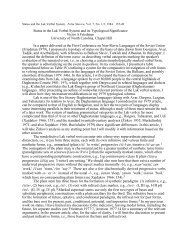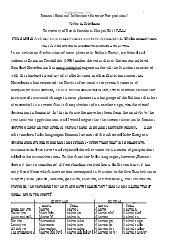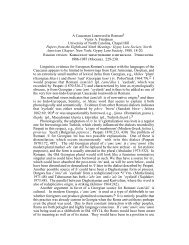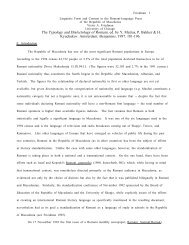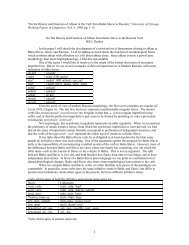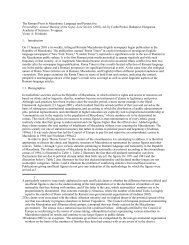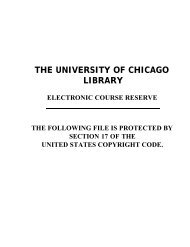Makedonia ve Civar Bölgelerde Balkan Türkçesi / Balkan Turkish in ...
Makedonia ve Civar Bölgelerde Balkan Türkçesi / Balkan Turkish in ...
Makedonia ve Civar Bölgelerde Balkan Türkçesi / Balkan Turkish in ...
You also want an ePaper? Increase the reach of your titles
YUMPU automatically turns print PDFs into web optimized ePapers that Google loves.
precisely where the same neutralization occurs <strong>in</strong> Slavic and Albanian, e.g. Kosova and Prilep.<br />
Moreo<strong>ve</strong>r, the quality of the palatals <strong>in</strong> the WRT dialects is the same as <strong>in</strong> the non-<strong>Turkish</strong><br />
contact languages. The automatic palatalization of <strong>ve</strong>lars before front vowels is characteristic of<br />
Standard <strong>Turkish</strong>, but the change from palatalized <strong>ve</strong>lars to palato-<strong>ve</strong>lars (k´, g´ ), palatal<br />
affricates (cˇ/c´, dzˇ, dz´ ) or palatal stops (t´, d´), while also a feature of northeast Anatolian<br />
<strong>Turkish</strong>, is characteristic of WRT on the <strong>Balkan</strong> Pen<strong>in</strong>sula (Németh 1961), and Hafız (1985),<br />
Ibrahimi (1982), Jasˇar-Nasteva (1969), and Jusuf (1978) all identify this as particularly<br />
characteristic of WRT (cf. also Asım 1976, Kakuk 1972, Katona 1969, Zaja˛czkowski 1968).<br />
Elim<strong>in</strong>ation of front rounded vowels, neutralization of high vowels (especially the high<br />
back unrounded), and palatalization of <strong>ve</strong>lars before front vowels (as well as peculiarities <strong>in</strong><br />
vowel harmony) all occur <strong>in</strong> Northeast Anatolia (Brendemoen 1984, 1989, 1992, 1996;<br />
Boeschoeten 1991; cf. also Johanson 1978/79, 1992:227). This raises the question of parallel<br />
de<strong>ve</strong>lopment or con<strong>ve</strong>rgence under respecti<strong>ve</strong> contact situations <strong>ve</strong>rsus a common heritage of<br />
<strong>in</strong>novation due to a northeast Anatolian orig<strong>in</strong> for WRT. Németh (1961) suggests the possibility<br />
of a northeast Anatolian orig<strong>in</strong> for the WRT dialects, but as Brendemoen has shown, these<br />
dialects themsel<strong>ve</strong>s display contact features <strong>in</strong> which Greek may ha<strong>ve</strong> played an conspicuous,<br />
perhaps e<strong>ve</strong>n substratal, role. This comb<strong>in</strong>ed with the Yuruk tradition that the WRT dialects are<br />
spoken by Islamicized autochthonous populations suggests that parallel de<strong>ve</strong>lopment may be the<br />
explanation for the similarities.<br />
An unquestionable contact phenomenon <strong>in</strong> WRT is phonemic /c/=[ts], which occurs <strong>in</strong> all<br />
the relevant contact languages and dialects and is found not only <strong>in</strong> loanwords but also <strong>in</strong><br />
producti<strong>ve</strong> affixes: lonats 'cup', tsapo 'goat', dayitsa 'aunt' (< dayı 'uncle'), okuydzˇitsa (=okuyucu)<br />
'woman who <strong>in</strong>vites one to a wedd<strong>in</strong>g' (Jasˇar-Nasteva 1970). F<strong>in</strong>al devoic<strong>in</strong>g of /g, v, z/, e.g. yus<br />
for yüz 'one hundred' (Jusuf 1987:73) occurs <strong>in</strong> both Macedonian and local Albanian (not <strong>in</strong><br />
Serbian).<br />
Ibrahimi (1982) associates the <strong>ve</strong>larization of clear /l/ after a front vowel if followed by<br />
pause or consonant, e.g. [bü¬bü¬] for bülbül 'night<strong>in</strong>gale', with Macedonian Muslim <strong>Turkish</strong>, e.g.<br />
[bu¬bu¬] as opposed to Macedonian <strong>Turkish</strong> [bü¬bül], Kosovan <strong>Turkish</strong>, [bülbül]. Although<br />
both Macedonian and Albanian ha<strong>ve</strong> a phonemic contrast between clear /l/ and <strong>ve</strong>lar /¬/, the<br />
contrast has an extremely low functional load <strong>in</strong> Macedonian, and for the most part the two<br />
sounds are <strong>in</strong> complementary distribution (only rarely does /l/ occur before a consonant, back<br />
vowel, or word f<strong>in</strong>ally). In Albanian, howe<strong>ve</strong>r, the two sounds are contrasted <strong>in</strong> all<br />
environments. In WRT <strong>in</strong> Macedonia, the tendency is to treat /l/ accord<strong>in</strong>g to Macedonian rather<br />
than <strong>Turkish</strong> distributional rules, whereas <strong>in</strong> Kosova, where Albanian is the dom<strong>in</strong>ant contact<br />
language, such is not the case.<br />
Other phenomena reported by Jasˇar-Nasteva (1969) and Jusuf (1988:67-68) as result<strong>in</strong>g<br />
from contact are loss of gem<strong>in</strong>ates (elli 'fifty' > eli) and toleration of <strong>in</strong>itial clusters (spanak vs<br />
ıspanak 'sp<strong>in</strong>ach').<br />
In morphophonology, lack of vowel harmony may be a contact <strong>in</strong>duced phenomenon, but<br />
the evidence is ambiguous. While lack of vowel harmony <strong>in</strong> the contact languages could <strong>in</strong>fluence<br />
the generalization of a gi<strong>ve</strong>n affix or the confusion of font/back or labial/non-labial harmony, some<br />
of these features could be archaisms preser<strong>ve</strong>d ow<strong>in</strong>g to lack of contact with the <strong>in</strong>novat<strong>in</strong>g<br />
dialects. Aga<strong>in</strong>, the similarity to northeast Anatolian raises the question of parallel archaism,<br />
parallel de<strong>ve</strong>lopment, or actual connection (Johanson 1978/79, 1992:223, Brendemoen 1992,<br />
Boeschoeten 1991).<br />
4



